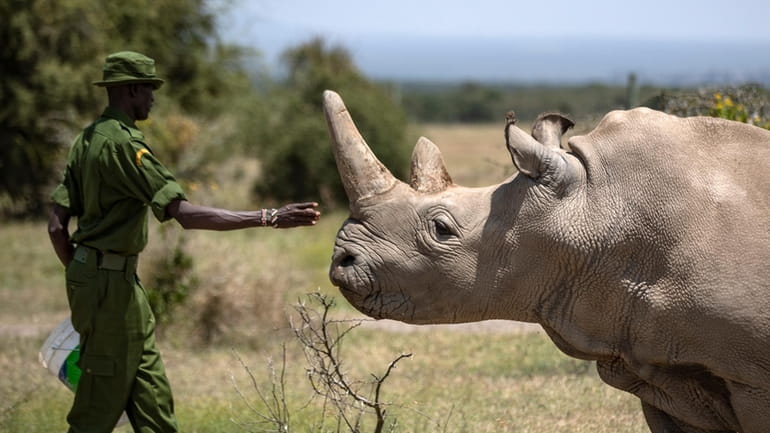A lesson in the fight to save a species

A ranger reaches out toward Najin, 30, a northern white rhino, in her enclosure at Ol Pejeta Conservancy in Kenya in 2019. Credit: AP/Ben Curtis
Extraordinary problems require extraordinary solutions. Often, these challenges elicit the best from us humans.
Such certainly has been the case with the impending extinction of the northern white rhino. There are two females left in the world, at a conservancy in Kenya. Both are past their reproductive age.
And yet now, despite the seeming mathematical impossibility of recovery, there is hope that this important subspecies might not die out. And there are reasons that we should care about that.
It's not just because of our complicity in their near-demise; the rhinos have been dwindling because of war, habitat loss, and poachers seeking their horns for their supposed medicinal value and worth as a status symbol.
Nor should we care simply because these rhinos play an important role in their ecosystem — they are considered a keystone species in their region of African grasslands because their prodigious grazing promotes biodiversity and helps prevent wildfires by keeping grasses short — or because losing any species is something to be concerned about.
Those are all good reasons. But we should particularly care about the fate of the northern white rhino because it's such a vivid example of a timeless human condition from which we never seem to learn: It's so much easier to create a problem than to solve it.
The last northern white male, named Sudan, died in 2018. His passing and the infertility of the two females that remain should have been a death warrant for the subspecies.
But scientists who saw that end coming saved the semen of Sudan and four other recently deceased male rhinos, and collected developing eggs called oocytes from the two females in Kenya and a few others who were still alive at the time in zoos around the world.
The plan was to use in vitro fertilization, a tried-and-true practice with humans but never done in rhinos, to keep the northern white rhinos going. First, scientists used the sperm to fertilize eggs from one of the Kenyan females, creating two embryos in 2019, a third in 2020, and now a total of 30 northern white rhino embryos from the one female.
At the same time, they also created embryos from the more populous southern white rhino and implanted two in a southern white rhino surrogate; they didn't want to use a precious northern white rhino embryo in case the experiment did not work. The transfer was successful, though the surrogate died from an unrelated infection before delivering the baby rhino.
Emboldened, scientists plan to implant a northern white rhino embryo into a different southern white rhino surrogate this year, and hope to continue that process until the northern whites can breed again in the wild. It's a plan with a long arc. Females don't reproduce until they are at least 6 years old, and males don't seek to mate until at least 10. Gestation is 16 to 18 months, with 2 to 3 years between calves. An optimistic guess on the timeline for reproduction in the wild is 10 to 15 years.
It is indeed extraordinary news from an extraordinary endeavor, but look at all the work and brainpower and expense and time that went into the effort to try to solve a problem that clearly was avoidable.
And then think about all the other problems we could have avoided or reduced in scope, problems from which we now are trying desperately to dig our way out. In this arena alone, in this era of what scientists say is a mass extinction, the disappearance of hundreds or thousand of species each year has environmental consequences we do not yet understand. We might be able to save the northern white rhino, but what else?
We start with small problems and let them fester, then try to make miracles to save us from ourselves.
Columnist Michael Dobie's opinions are his own.

